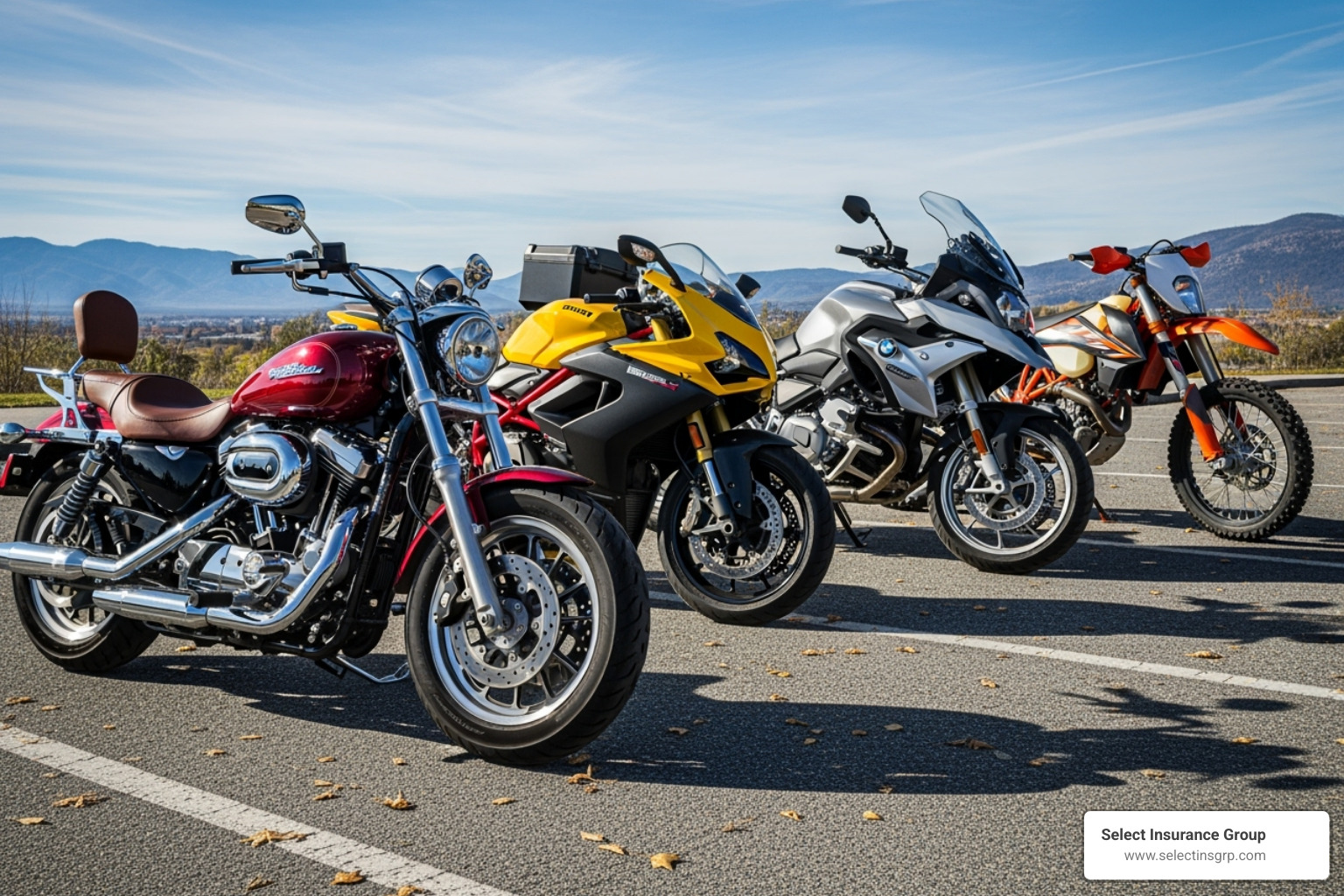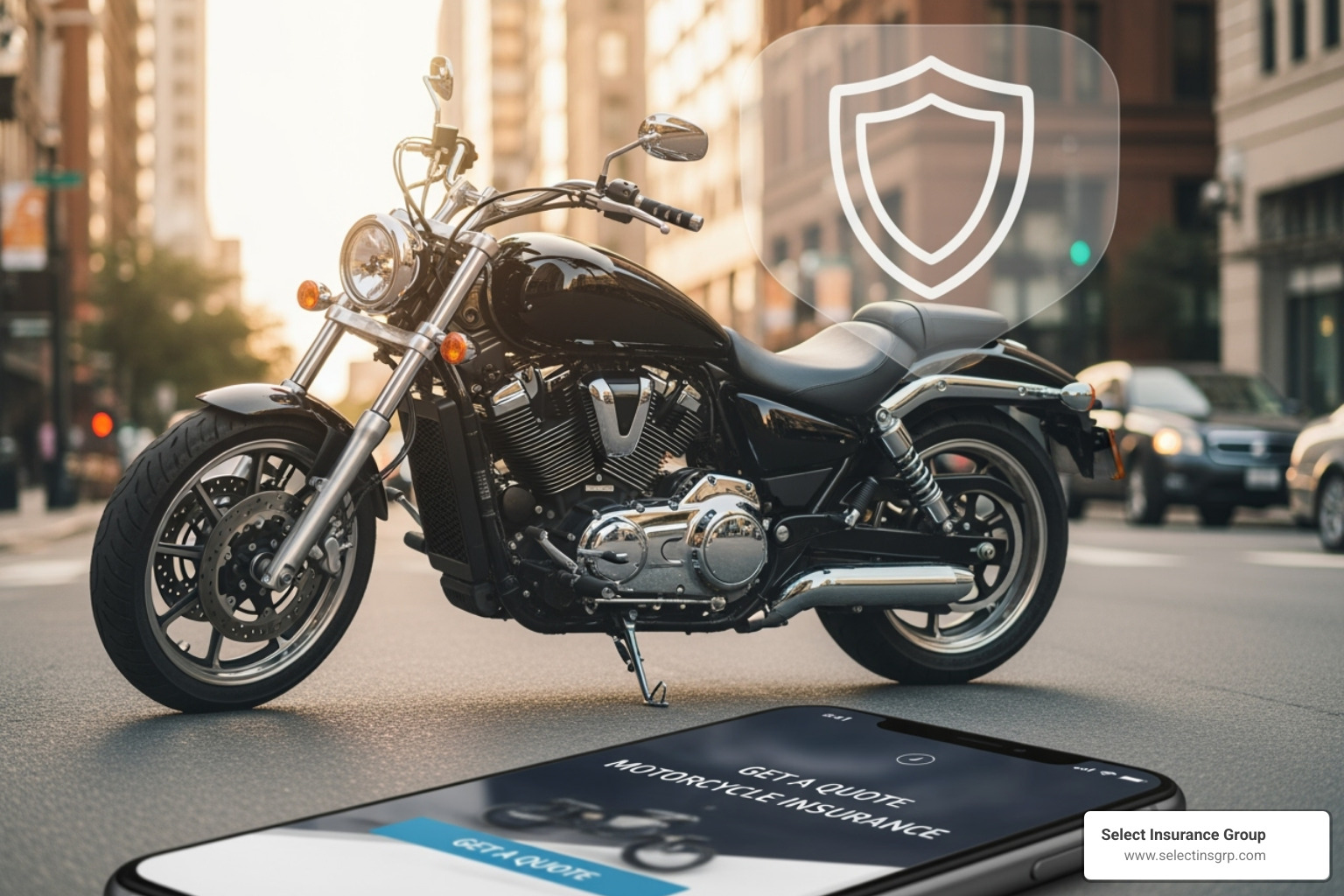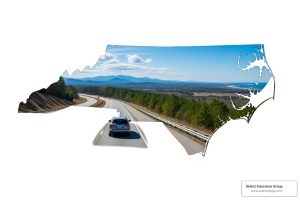Why Motorcycle Insurance is More Than Just a Legal Checkbox
Motorcycle insurance provides financial protection if you cause an accident, damage your bike, or get hurt while riding. Here’s a quick overview:
- Legally Required: Most states mandate insurance to ride on public roads.
- Liability Coverage: Pays for injuries or property damage you cause to others.
- Physical Damage Coverage: Collision and comprehensive protect your bike from accidents, theft, and weather.
- Medical Payments: Covers your and your passenger’s injuries after an accident.
- Variable Costs: Rates depend on your age, bike, location, and riding history, typically ranging from $200 to over $1,000 annually.
Riding without insurance puts your savings, assets, and riding privileges at risk. A single accident can lead to tens of thousands in damages.
Fortunately, motorcycle insurance is often more affordable than car insurance. Motorcycles generally have lower purchase, maintenance, and repair costs. Cruisers and standard bikes are cheaper to insure than sport bikes, and discounts for safety courses, policy bundling, and anti-theft devices can lower your premiums further.
Requirements vary in states like Florida, Georgia, and the Carolinas, but the need for protection is universal. The right coverage ensures you can ride without financial stress.
As the founder of Select Insurance Group, I’ve helped countless riders in the Southeast find affordable, effective motorcycle insurance. With access to over 20 carriers, we simplify comparing rates to get you the protection you need.

Quick motorcycle insurance definitions:
Understanding Your Coverage Options: From Basic to Full Protection
Choosing motorcycle insurance means finding a policy that fits your lifestyle and budget. Let’s review the options, from basic legal requirements to full protection.
Liability coverage is the foundation, required in nearly every state. It protects you financially if you’re at fault for an accident that injures someone or damages their property. It includes:
- Bodily Injury Liability: Covers medical bills and lost wages for people you injure.
- Property Damage Liability: Pays to repair or replace things you damage, like other vehicles or property.
Important: Liability does not cover your own injuries or your bike’s damage.
Collision coverage pays to repair or replace your motorcycle if it’s damaged in an accident with another vehicle or object, regardless of fault.
Comprehensive coverage protects against non-collision events like theft, vandalism, fire, hail, or a tree falling on your bike.
Uninsured/Underinsured Motorist (UM/UIM) coverage is critical. It pays for your medical bills and other losses if you’re hit by a driver with little or no insurance.
Medical Payments (MedPay) or Personal Injury Protection (PIP) helps cover medical bills for you and your passenger after an accident, no matter who is at fault.
| Coverage Type | What It Covers | What It Doesn’t Cover (Typically) |
|---|---|---|
| Collision | Damage to your motorcycle from an accident with another vehicle or object (e.g., guardrail, tree). | Theft, vandalism, fire, weather damage, injuries to others or yourself. |
| Comprehensive | Damage to your motorcycle from non-collision events like theft, vandalism, fire, hail, floods, falling objects. | Damage from a collision, injuries to others or yourself. |
Core Liability and Physical Damage Coverages
Consider these specialized coverages for added protection:
- Guest Passenger Liability: Included in most policies, this covers a passenger’s injuries if you’re at fault in an accident.
- Total Loss Coverage for a New Motorcycle: If your new bike is totaled, this pays the MSRP for a brand-new replacement, protecting you from depreciation.
- OEM Parts Coverage: Ensures repairs use genuine factory parts (Original Equipment Manufacturer) instead of aftermarket alternatives.
- Custom Parts & Accessories (CPE): Protects your investment in custom paint, chrome, or upgraded electronics. Most policies include a small amount of coverage ($2,000-$3,000), but you can purchase more.
Additional Protection for You and Your Gear
These add-ons provide peace of mind for common riding scenarios:
- Roadside Assistance: Provides towing, fuel delivery, and flat tire service if you break down.
- Trip Interruption: Reimburses you for lodging, meals, and transportation if your bike breaks down far from home.
- Safety Apparel Coverage: Replaces your helmet, jacket, and other gear if damaged in a covered accident.
- Rental Reimbursement: Helps pay for a rental vehicle while your bike is being repaired after a claim.
- Funeral Expense Coverage: Offers a benefit to help families cover final expenses in the event of a fatal accident.
At Select Insurance Group, we help riders from Florida to Virginia compare these options across 40+ carriers to find the perfect policy.
What Determines Your Motorcycle Insurance Rate?

Ever wonder why motorcycle insurance rates vary so much? Insurers use a detailed formula to assess your risk level, but understanding the factors involved can help you find significant savings.
Key Factors That Influence the Cost of Motorcycle Insurance
Insurers evaluate the following to set your rate:
- Age and Riding Experience: Younger, less experienced riders (especially under 25) face higher premiums due to statistical risk. Rates typically decrease with age and a safe riding history.
- Driving Record: A clean record lowers your rates. Accidents, tickets, and especially DUIs will increase your premiums for several years.
- Location: Urban areas with more traffic and higher theft rates usually have higher insurance costs than rural areas.
- Motorcycle Type: High-performance sport bikes cost more to insure than cruisers or touring bikes because they are involved in more accidents and have higher repair costs.
- Engine Size: A larger, more powerful engine generally means a higher premium.
- Annual Mileage: The more you ride, the higher your risk of an accident, which can increase your rate.
- Storage: Storing your bike in a locked garage is safer than parking it on the street and results in lower premiums.
- Coverage & Deductible: Higher coverage limits cost more, while a higher deductible (your out-of-pocket cost per claim) lowers your premium.
- Claims History: A history of filing claims, even for not-at-fault accidents, can lead to higher rates.
- Credit-Based Insurance Score: In many states, a better credit score can lead to lower insurance costs, as it correlates with fewer claims.
Smart Ways to Lower Your Premiums
You have several ways to reduce your motorcycle insurance costs without sacrificing key protections.
- Take a Motorcycle Safety Course: Completing an approved course from an organization like the Motorcycle Safety Foundation not only improves your skills but also qualifies you for a significant discount.
- Bundle Your Policies: Combining your motorcycle insurance with your auto or home policy is one of the easiest ways to save.
- Maintain a Clean Driving Record: Safe driving is the most effective long-term strategy for low rates.
- Install Anti-Theft Devices: Alarms, immobilizers, or GPS trackers reduce theft risk and earn you a discount.
- Insure Multiple Bikes: Adding more than one motorcycle to a policy usually results in a multi-bike discount.
- Choose a Higher Deductible: Opting to pay more out-of-pocket in a claim (e.g., $1,000 vs. $500) will lower your premium.
- Pay in Full: Paying your annual premium upfront often eliminates installment fees and may earn you a discount.
- Ask About a Lay-Up Policy: If you live in a climate with a cold season, this policy reduces coverage (and cost) during winter months when your bike is in storage.
- Join Rider Organizations: Members of groups like the Harley Owners Group (H.O.G.) may qualify for discounts.
- Report Low Annual Mileage: If you don’t ride often, let your insurer know to see if you qualify for a low-mileage discount.
An experienced agent can help you identify and stack these discounts to maximize your savings.
Navigating Legal Requirements and Getting a Quote

The freedom of riding comes with the responsibility to be properly insured. Before you ride, understand your state’s legal requirements for motorcycle insurance.
State-Specific Legal Requirements
Nearly every state requires a minimum amount of liability coverage to operate a motorcycle on public roads. This ensures you can cover damages if you cause an accident. For example, a state might require 25/50/25 coverage: $25,000 in bodily injury liability per person, $50,000 per accident, and $25,000 in property damage. Some states also mandate uninsured/underinsured motorist coverage or personal injury protection.
Beyond insurance, you’ll need a valid motorcycle license or endorsement. Helmet laws vary by state; some require them for all riders, while others only for those under a certain age (e.g., 21 in South Carolina). Many states also require headlights to be on at all times for visibility. Lane splitting is illegal in most states.
If you finance or lease your bike, your lender will almost always require full coverage (collision and comprehensive) to protect their investment, regardless of state minimums. Failing to maintain required coverage can lead to fines, license suspension, or impoundment.
We help riders steer the specific laws in North Carolina, South Carolina, Florida, and Georgia to ensure compliance without overpaying.
What Information Do You Need for a Motorcycle Insurance Quote?
Getting an accurate motorcycle insurance quote is straightforward. Having this information ready will speed up the process:
- Personal Information: Your full name, date of birth, and address.
- Driver’s License Number: To verify your driving record and riding experience.
- Motorcycle Details: The year, make, model, and Vehicle Identification Number (VIN).
- Riding History: Years licensed, plus any past accidents or violations.
- Desired Coverage: Know if you want basic liability or full coverage, and decide on a comfortable deductible.
- Motorcycle Usage: How you use the bike (commuting, pleasure), your estimated annual mileage, and where it’s stored overnight (e.g., a locked garage).
Providing accurate details is crucial for a valid policy and smooth claims process. We’ll guide you through these questions to find the most accurate and affordable quote.
Advanced Policy Considerations for Every Rider

Your motorcycle insurance policy is more than just a document; it’s a tool to be managed. Understanding how to use it, especially in unique situations, ensures you’re always protected.
Filing a Claim and Managing Your Policy
If you’re in an accident, stay calm and follow these steps:
- Prioritize Safety: Check for injuries and move to a safe location.
- Document Everything: Take photos of the scene, vehicle damage, and any injuries. Exchange contact and insurance information with other parties involved.
- Get a Police Report: If police respond, get the report number.
- Contact Your Insurer: Report the claim as soon as possible with all the details you’ve gathered.
Managing your policy is easier than ever. Most insurers offer online portals or mobile apps to make payments, view your policy, and access digital ID cards right from your phone.
Review your policy annually or after major life changes like moving, getting married, or modifying your bike. These events can affect your coverage needs and discount eligibility. We can help you adjust your policy to ensure it always fits your life.
Special Situations: Off-Season, Custom Bikes, and More
Motorcycle ownership presents unique insurance scenarios:
-
Off-Season Storage: Don’t cancel your insurance for the winter. A lapse in coverage leaves your bike unprotected from theft or fire and can increase your future premiums. Instead, ask about a “lay-up” policy. This reduces your coverage to comprehensive-only during storage months, saving you money while keeping the bike protected.
-
Custom and Vintage Bikes: A standard policy may not cover the full value of a heavily modified or classic motorcycle. An agreed value policy is a better option. You and the insurer agree on the bike’s value upfront, and if it’s totaled, you receive that amount, avoiding disputes over depreciation.
-
Quality Repairs: Some policies specify coverage for Original Equipment Manufacturer (OEM) parts, ensuring repairs use genuine factory components. If you have custom parts, make sure your policy includes adequate accessory coverage to protect your modifications.
Frequently Asked Questions About Motorcycle Insurance
We’ve answered thousands of motorcycle insurance questions over the years. Here are some of the most common ones.
Does motorcycle insurance cover passengers?
Yes. If you cause an accident, your bodily injury liability coverage helps pay for your passenger’s medical bills and other damages, up to your policy limits. This is often called guest passenger liability and is typically included automatically.
Additionally, Medical Payments (MedPay) or Personal Injury Protection (PIP) coverage can pay for your passenger’s medical expenses regardless of who was at fault. If you frequently ride with a passenger, it’s wise to review your liability limits to ensure they are sufficient.
What should I do if my motorcycle is stolen?
First, call the police immediately to file a report. You will need the report number for your insurance claim.
Next, contact your insurance provider. Theft is covered if you have comprehensive coverage on your policy. Your insurer will guide you through the claims process. If your bike isn’t recovered, your insurance company will pay you its actual cash value at the time of the theft, minus your deductible. Specialized policies like agreed value or new bike replacement can offer better payouts.
To prevent theft, use locks, install an alarm or GPS tracker, and store your bike in a secure location like a locked garage.
What types of motorcycles are typically covered?
Motorcycle insurance is available for a wide variety of two- and three-wheeled vehicles. We work with carriers that insure nearly all types, including:
- Cruisers and Touring Bikes: Generally the most affordable to insure.
- Sport Bikes: Insurable, but premiums are higher due to their performance capabilities and risk profile.
- Mopeds and Scooters: Very affordable to insure due to smaller engines and lower speeds.
- Dirt Bikes, ATVs, and UTVs: Coverage is available, especially if they are street-legal or used in organized events.
- Custom Choppers and Modified Bikes: Require specialized coverage for custom parts and accessories (CPE) or an agreed value policy to protect your investment.
- Trikes and Autocycles: These three-wheeled vehicles are fully insurable under motorcycle policies.
Essentially, if it has two or three wheels and a motor, we can likely find a policy for it.
Conclusion: Ride with Confidence
There’s nothing like the freedom of the open road. The smartest riders know that motorcycle insurance is what allows you to enjoy that freedom without financial worry.
This guide has covered the essentials, from basic coverage to legal requirements and cost-saving strategies. The key takeaway is that the right policy balances cost with the specific protection you need for your bike and riding style.
Your life and riding habits change, so we recommend an annual policy review. Whether you’ve added custom parts, moved, or changed how much you ride, your coverage should adapt.
At Select Insurance Group, we’ve spent over 30 years helping riders across Florida, the Carolinas, Virginia, and Georgia. By shopping over 40 carriers, we find the best rates without cutting corners. We know motorcycle insurance and are dedicated to getting you on the road with confidence.
Whether you’re a new rider or a seasoned veteran, you deserve insurance that works for you. Don’t leave your passion unprotected.
Ready to ride with real peace of mind?









